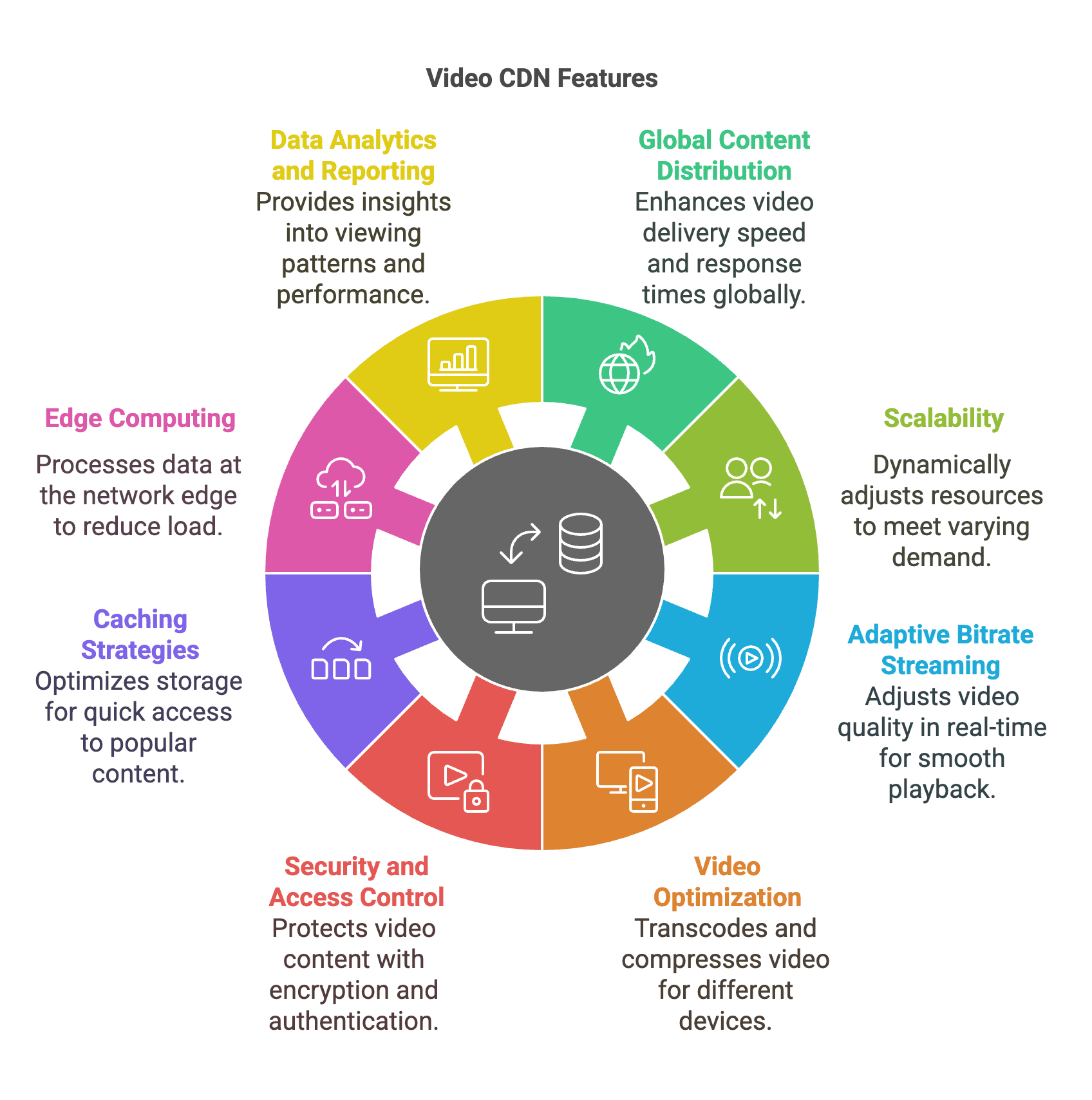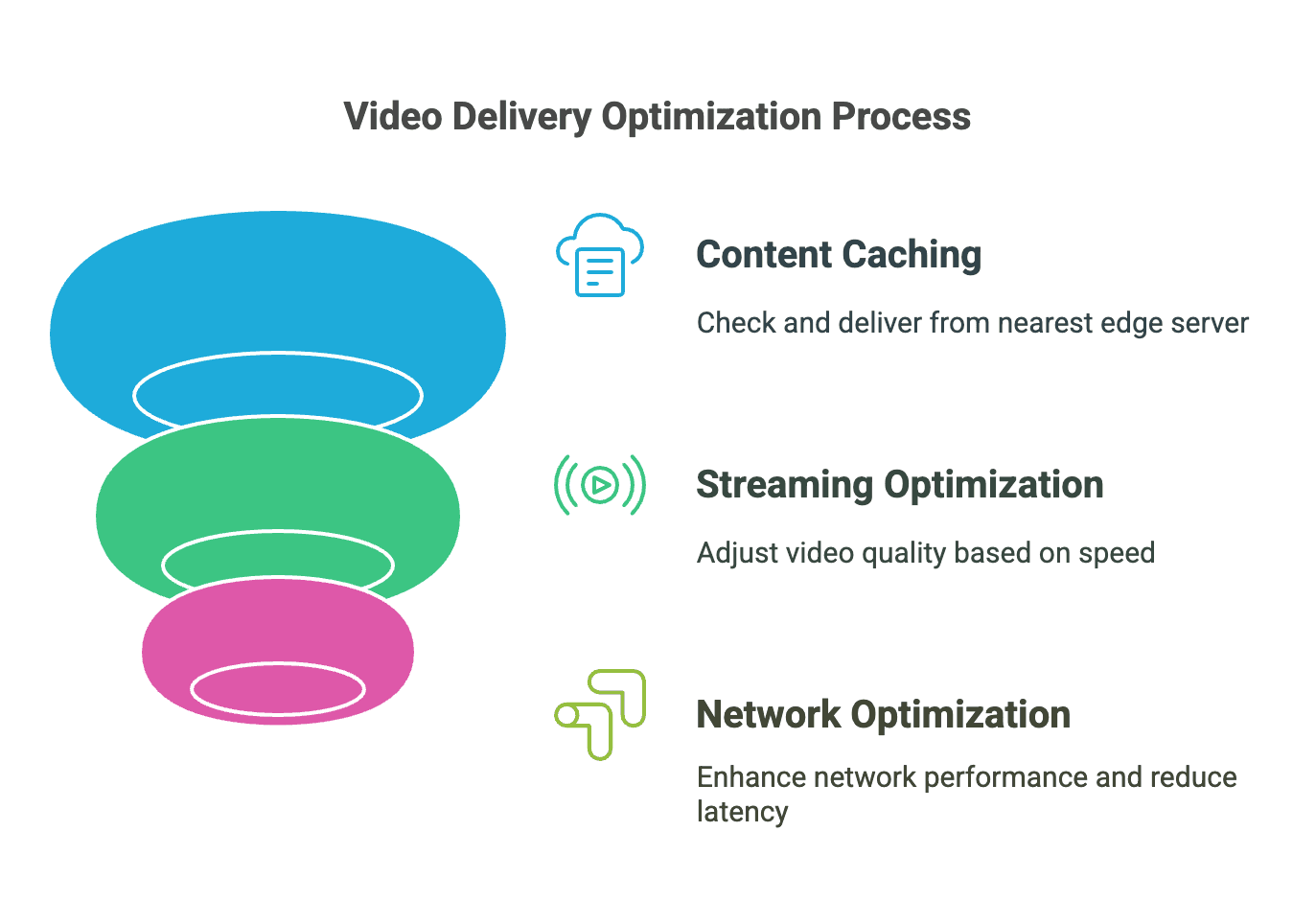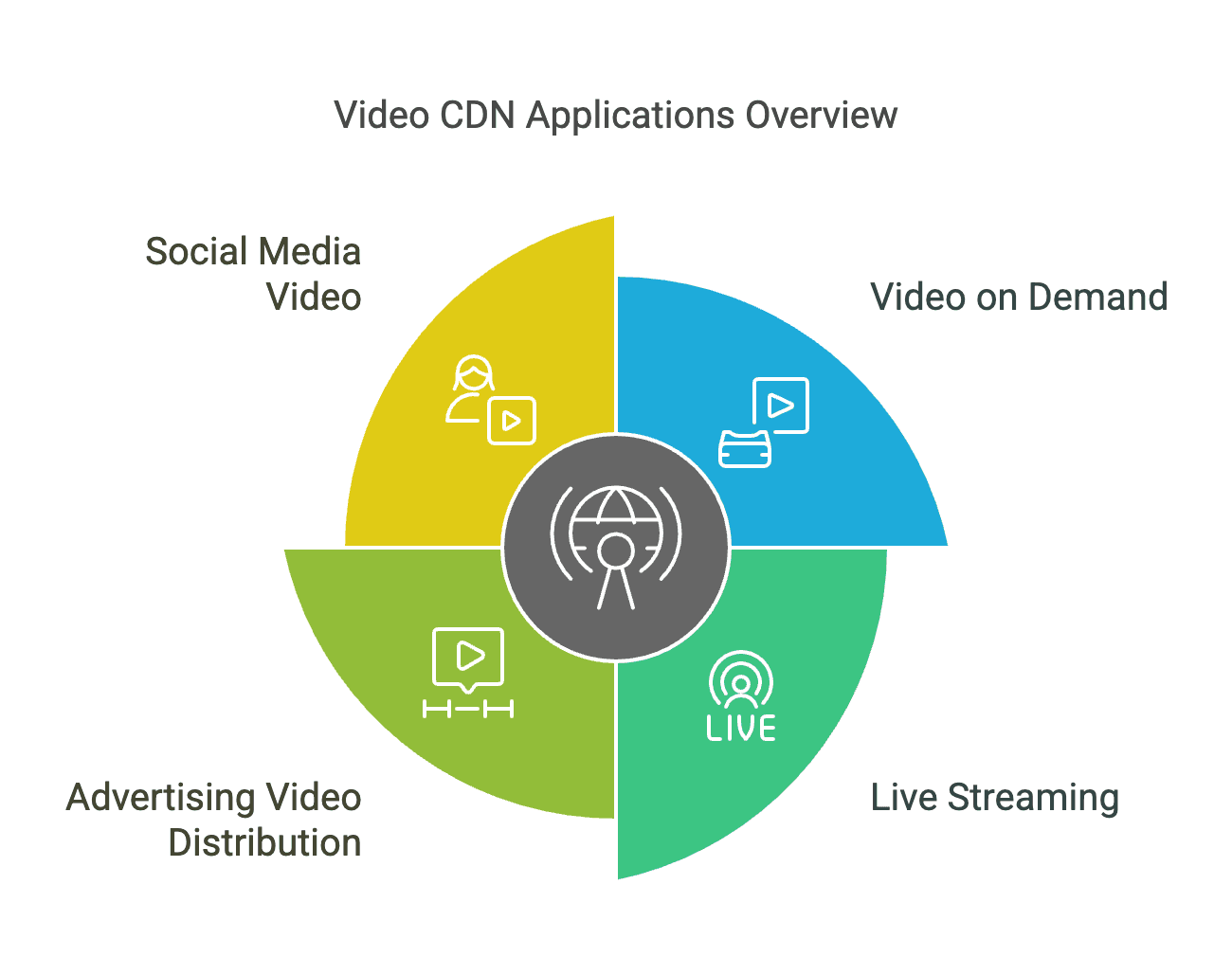In the digital age, the consumption of video content has skyrocketed, becoming an integral part of our daily lives. From streaming movies and TV shows to live events and social media videos, the demand for high-quality, seamless video experiences is at an all-time high. However, delivering video content efficiently and effectively poses significant challenges. High traffic demands, bandwidth constraints, and the need for a consistent user experience across diverse geographic locations are just a few of the hurdles that content providers face. This is where Video CDN (Content Delivery Network) comes into play, offering a solution that not only meets these challenges but also enhances the overall video delivery process.
What is a Video CDN?
The exponential growth of video content has led to an unprecedented demand for bandwidth. Streaming services, live events, and social media platforms all require robust infrastructure to handle the massive amounts of transmitted data. Without proper optimization, video delivery can suffer from buffering, low-quality playback, and slow load times, all of which degrade the user experience. Ensuring that users can access high-quality video content quickly and reliably, regardless of their location, is crucial for maintaining audience engagement and satisfaction.
A Video CDN is a specialized type of CDN designed specifically for the efficient delivery of video content. It leverages a network of servers distributed across the globe to cache and deliver video files closer to the end-users. Doing so reduces the load on the origin server, minimizes latency, and ensures faster content delivery. The core functions of a Video CDN include content caching, optimized streaming, and network acceleration, all of which work together to provide a seamless and high-quality video experience.
The main features of Video CDNs include:
- Global Content Distribution: Video CDNs speed up content transfer and improve response times by deploying multiple data centers worldwide and caching video content on servers closest to users.
- Scalability: Video CDNs can dynamically scale resources according to demand, providing sufficient bandwidth and server resources to handle peak user access, whether for small-scale video releases or large-scale live events.
- Adaptive Bitrate Streaming: Video CDNs support adaptive bitrate streaming technology, which adjusts video quality in real-time based on the user's network conditions, ensuring smooth playback even under poor network conditions.
- Video Optimization: Video CDNs can perform real-time transcoding and compression of video to meet the needs of different devices and network environments while maintaining video quality.
- Security and Access Control: Video CDNs offer various security measures, including SSL/TLS encryption, DDoS protection, content encryption, and token authentication, to ensure secure video content transmission and prevent unauthorized access.
- Caching Strategies: Video CDNs can optimize caching strategies based on the popularity and frequency of content access, ensuring that popular content is always quickly accessible while efficiently managing storage space.
- Edge Computing: Some video CDNs offer edge computing capabilities, allowing data processing and application logic execution at the network edge, reducing the need for data transmission to central servers.
- Data Analytics and Reporting: Video CDNs typically provide real-time monitoring and analytics tools to help content providers understand video viewing patterns, user behavior, and performance metrics for optimization and decision-making.
- Multi-Protocol Support: To meet the needs of different devices and platforms, they support various streaming media transmission protocols, such as HTTP Live Streaming (HLS) and Dynamic Adaptive Streaming over HTTP (DASH).

How Video CDNs Work
Content Caching and Distribution
One of the fundamental principles of a Video CDN is content caching. When a user requests a video, the CDN checks if the content is already cached on a nearby edge server. If it is, the video is delivered directly from the edge server, significantly reducing the distance the data has to travel and thereby lowering latency. Edge nodes, strategically placed around the world, play a crucial role in this process. They store frequently accessed content and serve it to users in their vicinity, ensuring that popular videos are readily available without needing to fetch them from the origin server each time.
Video Streaming Optimization
Video streaming involves delivering video content continuously, allowing users to watch without waiting for the entire file to download. Adaptive bitrate streaming is a key technology used by Video CDNs to optimize this process. It dynamically adjusts the video quality based on the user's internet speed, ensuring smooth playback even in varying network conditions. By segmenting the video into smaller chunks, the CDN can deliver each segment as needed, reducing buffering times and improving load speeds.
Network Optimization and Acceleration
Efficient network optimization is essential for delivering video content at scale. Video CDNs employ various techniques to enhance network performance. TCP optimization, for example, involves fine-tuning the transmission control protocol to improve data transfer rates and reduce packet loss. Additionally, advanced protocols like QUIC (Quick UDP Internet Connections) are increasingly being adopted to accelerate video delivery further. Bandwidth management and traffic control mechanisms ensure that the network can handle high traffic volumes without congestion, providing a consistent experience for all users.

What are the Advantages of Video CDN?
Performance Improvement
The primary benefit of using a Video CDN is the significant performance improvement. By caching content on edge servers, the CDN reduces the distance data has to travel, resulting in lower latency and faster load times. This is particularly important for live streaming, where real-time delivery is critical. Global coverage and localized service delivery ensure that users around the world can access content quickly, regardless of their location. This not only enhances the user experience but also helps in expanding the reach of content providers.
Cost Reduction
Video CDNs can significantly reduce the operational costs associated with video delivery. By offloading traffic from the origin server, the CDN minimizes the bandwidth consumption at the source, reducing the need for expensive infrastructure upgrades. Additionally, the optimized delivery process means that content providers can serve more users with the same amount of resources, making it a cost-effective solution. The ability to scale up or down based on demand also helps in managing costs more efficiently.
Enhanced Security
Security is a crucial aspect of content delivery, especially for video content that may include copyrighted material or sensitive information. Video CDNs offer robust security features to protect content from unauthorized access and distribution. Content encryption ensures that videos are securely transmitted over the network, preventing interception and piracy. Anti-leeching mechanisms prevent unauthorized third parties from embedding or linking to the content. Additionally, CDNs provide DDoS protection and Web Application Firewalls (WAF) to safeguard against cyber-attacks, ensuring that the content delivery process remains uninterrupted.
Applications of Video CDN
Video on Demand (VOD)
Video on Demand services have revolutionized the way we consume media. Platforms like Netflix, Amazon Prime, and Hulu rely heavily on Video CDNs to deliver their extensive libraries of movies and TV shows to users around the world. The CDN ensures that content is available quickly and in high quality, providing a seamless viewing experience. By caching popular content on edge servers, the CDN can handle high traffic volumes during peak times, ensuring that users can stream their favorite shows without interruptions.
Live Streaming
Live streaming has become increasingly popular for events such as sports, concerts, and online gaming. The ability to deliver live content in real time is critical for maintaining audience engagement. Video CDNs are designed to handle the high concurrency and low latency requirements of live streaming. They ensure that the video stream is delivered smoothly to viewers around the world, with minimal delay. This is achieved through advanced streaming protocols and efficient network optimization techniques that prioritize live content delivery.
Advertising Video Distribution
Advertising videos are an essential part of the digital media landscape. Advertisers need to ensure that their video ads load quickly and play smoothly to maximize their effectiveness. Video CDNs provide the necessary infrastructure to deliver advertising videos efficiently, ensuring high reach and engagement. By caching ad content on edge servers, the CDN reduces load times and improves the overall performance of ad delivery, contributing to higher ad revenues for publishers and better ROI for advertisers.
Social Media Video
Social media platforms are a major source of video content, with users sharing and consuming vast amounts of user-generated videos daily. Platforms like Facebook, Instagram, and TikTok rely on Video CDNs to handle the high volume of video uploads and views. The CDN ensures that videos are delivered quickly and reliably, even during peak traffic periods. By optimizing video delivery, the CDN helps maintain a smooth user experience, encouraging more video sharing and engagement on social media platforms.

Best Service Providers of Video CDN
EdgeOne
Tencent EdgeOne provides seamless Video on Demand (VOD) solutions for fast, reliable streaming of high-quality video content, and enhances site performance by leveraging Tencent's extensive global network infrastructure and advanced caching and optimization techniques. It offers a rapid video encryption solution, combining hotlink protection and encrypted adaptive bitrate streaming. The Player SDK allows seamless integration into mobile and web clients, enabling features like resolution switching, thumbnail preview, video preview, and encrypted playback. Backed by a robust backend, VOD supports full video services from upload and transcoding to playback and acceleration.
Akamai
Akamai is a leading provider of Video CDN services, known for its extensive global network and advanced delivery technologies. The company offers a range of solutions designed to optimize video streaming, including adaptive bitrate streaming, content caching, and network optimization. Akamai's robust security features, such as DDoS protection and content encryption, make it a trusted choice for content providers worldwide.
Cloudflare
Cloudflare is another major player in the Video CDN market, offering a comprehensive suite of services that combine content delivery with robust security. The company's focus on performance optimization and security ensures that video content is delivered quickly and safely. Cloudflare's Web Application Firewall and DDoS protection mechanisms provide an additional layer of security, safeguarding against potential threats. Its global network of data centers enables efficient content delivery to users around the world.
Fastly
Fastly is known for its high-speed content delivery and real-time performance capabilities. The company's Video CDN solutions are designed to handle large-scale video streaming with minimal latency. Fastly's edge computing platform allows for real-time processing and optimization of video content, ensuring a seamless viewing experience. Its commitment to innovation and performance makes it a popular choice for content providers looking to deliver high-quality video content quickly and reliably.
Other Key Providers
Other notable players in the Video CDN market include Amazon Web Services (AWS), Google Cloud, and Microsoft Azure. These cloud service providers offer robust CDN solutions as part of their broader cloud infrastructure, leveraging their extensive resources and expertise to deliver efficient and reliable video content.
Future Outlook of Video CDN
The global Video CDN market is experiencing rapid growth, driven by the increasing demand for video content and the need for efficient delivery solutions. According to market research reports, the market size is expected to expand significantly over the next few years, with major players investing heavily in infrastructure and technology. The primary drivers of this growth include the rise in online video consumption, the proliferation of mobile devices, and the increasing adoption of streaming services.
Future Technological Directions
The future of Video CDN is closely tied to advancements in technology. The advent of 5G networks promises to revolutionize video delivery, offering higher speeds and lower latency. This will enable more immersive experiences, such as 4K and 8K streaming, virtual reality, and augmented reality content. Additionally, the integration of AI and machine learning will allow for more personalized content delivery, optimizing the viewing experience based on individual user preferences and behavior.
Cloud-native CDNs are gaining traction, leveraging the scalability and flexibility of cloud computing to deliver video content more efficiently. The integration of edge computing allows for even faster content delivery by processing data closer to the user. Additionally, the application of AI and machine learning technologies is becoming more prevalent, enabling intelligent traffic management, content optimization, and predictive analytics. These advancements will further enhance the performance and capabilities of Video CDNs.
Market Opportunities and Challenges
The global Video CDN market is diverse, with different regions experiencing varying levels of growth and adoption. North America and Europe have well-established markets, driven by the presence of major content providers and advanced infrastructure. However, the Asia-Pacific region is emerging as a significant growth area, fueled by the rapid expansion of the digital media market and the increasing number of internet users. Emerging markets in other regions also present expansion opportunities, as more countries adopt digital media and streaming services.
The growing demand for video content presents significant market opportunities for Video CDN providers. The rise of new applications, such as e-learning platforms, telemedicine, and smart cities, will further drive the need for efficient video delivery solutions. However, providers also face challenges, such as increasing competition, cost pressures, and the need to comply with evolving regulatory requirements. Balancing innovation with cost-effectiveness and security will be crucial for success in the market.
Conclusion
In summary, Video CDNs play a vital role in the digital media landscape, enabling the efficient and high-quality delivery of video content. As technology continues to advance and the demand for video grows, Video CDNs will remain at the forefront of innovation. Their ability to enhance performance, reduce costs, and provide robust security makes them an essential component for content providers looking to thrive in the digital age. The future of Video CDN looks promising, with new opportunities emerging as the industry evolves.
Compared to traditional CDN, Tencent EdgeOne offers a broader range of features and serves as a comprehensive one-stop platform that addresses both acceleration and security requirements. Its risk-avoidance capabilities allow billing based on clean traffic after cleansing, eliminating concerns about unexpectedly high bills. At the same time, operational efficiency is further improved, such as free certificate automatic updates, site-level batch management, and saving a lot of tedious steps. It also supports personalized capability customization: Rule Engines and Edge Functions can flexibly adapt to different business scenarios. The billing model is more reasonable, offering subscription packages and excess pay-as-you-go.
- Cost savings: A one-stop solution is more cost-effective than purchasing individual products separately. Billing based on clean traffic after protection avoids unexpected high bills, making budget management easier.
- Increased efficiency and speed: The integration of acceleration and security analysis helps users quickly locate problems; configuration and operation management are more efficient within a single console.
- Inclusive security: Enjoy advanced Web protection and platform-level DDoS protection at a low cost, combined with advanced semantic analysis engines and intelligent BOT analysis, accurately identifying malicious requests and reducing false positives.
- Flexible configuration: Edge functions, rule engines, and other product capabilities enable more personalized and customized business solutions, allowing flexible adaptation to different business scenarios.
- Audio/Video Acceleration: Based on Tencent's many years of online video operations experience and optimized for online audio/video playback business scenarios. EdgeOne can support many concurrent requests during peak hours while effectively ensuring high service availability and satisfactory media transfer speed, helping you deliver a stable, smooth, and rich-featured watch experience.
FAQs of Video CDN
1. What is a Video CDN?
A Video CDN (Content Delivery Network) is a network of servers strategically distributed across various locations to deliver video content efficiently to users. It helps improve the speed, reliability, and quality of video streaming by caching content closer to the end-user.
2. How does a Video CDN work?
When a user requests a video, the CDN routes that request to the nearest server in its network. The CDN caches video content on these edge servers so that it can be delivered quickly without needing to retrieve it from the origin server every time.
3. What are the benefits of using a Video CDN?
Key benefits include:
- Faster Load Times: Reduced latency by delivering content from a nearby server.
- Scalability: Ability to handle large volumes of traffic and simultaneous viewers without performance degradation.
- Reliability: Improved uptime and reduced risk of interruptions due to server failures or high traffic.
- Global Reach: Enhanced delivery for a global audience through a distributed network.
4. Who uses Video CDNs?
Video CDNs are used by a variety of organizations, including streaming services, media companies, educational institutions, gaming companies, and any business that delivers video content online.
5. What types of content can be delivered via a Video CDN?
Video CDNs primarily deliver video content, but they can also handle audio files, images, and other static assets. They support various formats, including live streams, on-demand videos, and adaptive bitrate streaming.
6. Are there different types of Video CDNs?
Yes, there are several types of Video CDNs, including:
- Public CDNs: Open for anyone to use (e.g., Akamai, Cloudflare, Amazon CloudFront).
- Private CDNs: Operated by specific organizations for internal use or exclusive customers.
- Hybrid CDNs: Combine both public and private CDN capabilities to meet specific needs.
7. What is adaptive bitrate streaming?
Adaptive bitrate streaming is a technique used by CDNs to deliver video content in multiple quality levels. The CDN dynamically adjusts the video stream based on the viewer's internet connection speed and device capabilities, ensuring optimal playback and minimal buffering.
8. How do I choose the right Video CDN for my needs?
Consider factors such as:
- Performance: Look for CDNs with low latency and high availability.
- Global Coverage: Ensure the CDN has a sufficient number of edge servers worldwide.
- Pricing Structure: Evaluate costs associated with bandwidth, storage, and additional features.
- Integration: Check compatibility with your existing systems and video players.
- Support and Reliability: Research customer service and uptime guarantees.
9. What are the costs associated with using a Video CDN?
Costs can vary widely depending on factors like usage volume, geographic reach, and specific features offered. Common pricing models include pay-as-you-go (based on data transfer) and monthly subscription plans.
10. Can I use a Video CDN for live streaming?
Yes, most modern Video CDNs support live streaming capabilities, allowing you to broadcast live events to large audiences while maintaining quality and minimizing latency.

